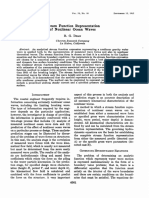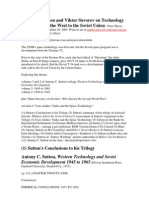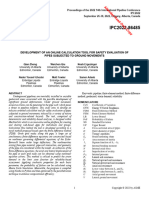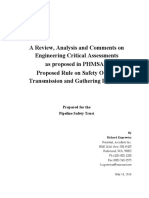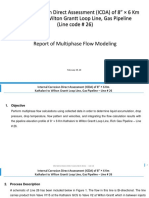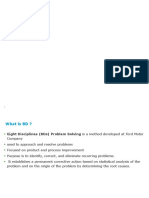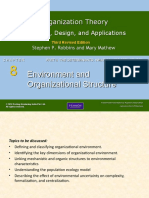Section 1 - Scope (FITNET)
Section 1 - Scope (FITNET)
Uploaded by
Roberto LacalleCopyright:
Available Formats
Section 1 - Scope (FITNET)
Section 1 - Scope (FITNET)
Uploaded by
Roberto LacalleCopyright
Available Formats
Share this document
Did you find this document useful?
Is this content inappropriate?
Copyright:
Available Formats
Section 1 - Scope (FITNET)
Section 1 - Scope (FITNET)
Uploaded by
Roberto LacalleCopyright:
Available Formats
Jan.
2008 FITNET MK8
1 Scope
1.1 Philosophy of FITNET FFS approach
The approach described in this procedure is suitable for the assessment of metallic structures and
components with and without welds containing, or postulated to contain, flaws. The failure mechanisms
considered are fracture, fatigue, creep and corrosion, together with combinations of these failure modes. In
order to facilitate a unified assessment route through the FITNET FFS procedure, information is grouped
under following main Sections:
• Information required for assessment (Inputs): Section 5
• Assessment modules
-Fracture Module: Section 6
-Fatigue Module: Section 7
-Creep Module: Section 8
-Corrosion Module: Section 9
• Assessment and reporting of results (Output): Section 10
• Alternative and specific assessments for fracture: Section 11
• Additional information for fracture assessment: Section 12
The Volume I of the FITNET FFS Procedure contains these 12 Sections.
The Volume II contains Annexes and an additional volume contains case studies and tutorials used in FITNET
Training and Education seminars as well as to demonstrate cases used for validation of the procedures.
The philosophy of the approach in each of four assessment modules (Fracture, Fatigue, Creep and Corrosion
Modules) is differently structured. The following section provides short information on the modules of the
FITNET FFS Procedure.
Fracture Module:
The quality of input data is reflected in the sophistication and accuracy of the resulting analysis. A series of
levels is available, each of increasing complexity and each being less conservative than the next lower level;
consequently 'penalties' and 'rewards' accrue from the use of poor and high quality data respectively. This
procedural structure means that an unacceptable result at any level can become acceptable at a higher one.
The user need only perform the work necessary to reach an acceptable level and need not invest in
unnecessarily complicated tests or analysis.
Due to the hierarchical structure of data and assessment levels, the path selection through the procedure is
made based on the relative levels of contribution of brittle fracture and plastic collapse towards the overall
failure. Qualitative and quantitative guidance is provided for guiding the user in the direction that will yield
most benefit in terms of data improvement. The basis for this is the location of the initial analysis point in terms
of brittle fracture and plastic collapse. This can be assessed by either the Failure Assessment Diagram (FAD)
or the Crack Driving Force curve (CDF). The methods can be applied to determine the acceptability of a given
set of conditions, determine the value of a critical parameter, assess the safety margins against failure or
determine the probability of failure. Figure 1.1 shows the general decision steps and possible outcome.
© FITNET 2008 1-1
FITNET FFS – MK8 – Section 1: Scope
User knowledge Data quality Assessment aim
Type of
Type of data thoughness
data
Allowance for
mismatch?
Select level
Characteristic flaw Primary &
Analysis secondary stress
size
Select approach
Data distribution
Critical Safety Probabilistic
Acceptability margin
parameter analysis
Partial safety factors if appropriate
Satisfactory outcome?
Yes No
No further action
Refine data inputs, move to
required: report results
higher analysis option, re-
rate* or concede failure
* Re-rate could mean raising the NDT, reducing pressure etc.
Figure 1.1 - Generalised flowchart of decision steps and types of outcome for Fracture Module
1-2 © FITNET 2008
Jan. 2008 FITNET MK8
Fatigue Module:
In the FITNET FFS fatigue analysis there is a principal need to determine whether the analysis is intended to
determine the cyclic life to fatigue crack initiation for a specified load history at a critical location or to evaluate
the propagation of a reported or postulated flaw up to a critical size to produce fracture or local collapse.
Obviously, both aspects may need to be considered in cases for which the location of the reported flaw does
not coincide with that of highest loading. This Module provides five assessment routes for evaluating the
effects of cyclic loads on the service life of the defect-free component or component with postulated or real
defects. The FITNET FFS Fatigue Damage Assessment Routes are: Route 1) Nominal Stress, Route 2)
Structural Stress or Notch Stress, Route 3) Strain-Based Fatigue Life Curves, Route 4) Fatigue Crack
Propagation, Route 5) Non-Planar Flaw Assessment.
Covered by the above five assessment routes, two basic application scenarios are foreseen in the Fatigue
Module:
a) A design detail or feature of a component is to be assessed with respect to potential fatigue failure from that
feature, rather than from any identifiable flaw. The analysis is then based on the accumulation of fatigue
damage at a critical location on the component (fatigue damage analysis). In this case, the basic approach is
to determine the fluctuating stress range at the location under study and relate the analysis to the appropriate
fatigue life curves. Three different routes are proposed (Routes 1, 2 and 3), depending on the available
information about loading and flaw information, fatigue regime, and application specification (i.e., welded or
non welded component).
b) An actual or postulated flaw is to be assessed with respect to potential growth to a critical size under fatigue
loading. In general, such flaws would be considered to be planar (crack-like) regardless of their actual type. In
this case the analysis is focused on determination of the cyclic growth of the flaw (Route 4). However, a
supplementary, less conservative route is included specifically for assessing volumetric non-planar flaws
(Route 5).
FITNET Fatigue Module
No Detected or Yes
postulated
defect?
FITNET damage Flaw characterized as
analysis (FDA) planar
Yes No
Nominal Yes Nominal stress
stress fatigue analysis
approach? Fatigue crack Assessment
(Route 1)
growth (FCC) of non-
analysis planar flaws
No (Route 4) (Route 5)
Structural Yes Structural notch
notch stress stress fatigue
approach? analysis (Route 2)
No
Nonlinear, local
stress-strain Fatigue life
analysis (Route 3) estimate
Figure 1.2 – Generalised flowchart of assessment routes for fatigue module
© FITNET 2008 1-3
FITNET FFS – MK8 – Section 1: Scope
Creep Module:
The creep module specifies methods for assessing defects in structures operating at high temperatures and
subject to creep-fatigue loading conditions, see flow-chart shown in Figure 1.3. Creep is a time-dependent
phenomenon. Therefore, the creep module evaluates the times associated with three significant events. First,
the initiation time is the time prior to which no significant crack growth occurs. Secondly, the time associated
with creep-fatigue crack growth or the crack growth in a specified time is calculated. Finally, the time for creep
rupture damage to spread throughout the ligament ahead of a flaw must be evaluated. This last time can be
life-limiting even if no significant crack growth occurs in service.
Creep crack growth in Section 8 is generally based on reference stress methods for calculating the steady
*
state creep parameter, C . These methods are similar in basis to those used in the fracture module. Indeed,
the creep module includes an alternative time-dependent failure assessment diagram, which reduces to the
failure assessment diagram approach in the fracture module when creep strains are negligible. The creep
module also includes other alternative approaches and guidance for some specific applications.
Corrosion Module:
The corrosion module provides guidelines on the appropriate steps to take when an environmental assisted,
either by stress corrosion or corrosion fatigue, crack as well as local thin area (LTA) has been detected in
service and an assessment of the implications for structural integrity has to be done. Such an evaluation
should be made in the context of the perceived consequences of failure using appropriate risk-based
management methodologies. Since this is plant/component specific it is beyond the scope of this section. Hence,
this Module deals primarily with the Fitness-for-Service assessments of damage types due to environmental
assisted cracking (EAC), Figure 1.4, - covering stress corrosion cracking and corrosion fatigue – and Local
Thinned Area (LTA).
1.2 Limits of validity
The methods described in this procedure were derived by reviewing and collating existing information and
utilising the results of recently completed EU-Projects in the field of FFS. Furthermore, existing standards
such as R6 and BS 7910 as well as results of the SINTAP procedure have been used to develop various
sections of this procedure.
The materials to which the procedure can be applied cover the full range of metallic materials. Emphasis
throughout has been given to strength mis-matched welds in the Fracture Module.
The procedure is applicable to combinations of the following failure modes.
• Fracture
• Fatigue
• Creep and other high temperature failure modes
• Corrosion (Environmentally assisted cracking, local thin areas)
The failure mode of buckling is not covered by this procedure.
1-4 © FITNET 2008
Jan. 2008 FITNET MK8
Establish cause of cracking.
Characterize initial defect
Is there evidence of stress corrosion Yes Special
cracking, environmentally assisted Step 1
considerations
cracking or bulk creep damage?
Define plant history and future operational
requirements: steady service loads, Step 2
temperatures; other loadings; life to date t0;
future life required, ts
Collect materials data Step 3
Perform basic stress Step 4
analysis
Calculate margin against
time-independent fracture Step 5
for initial defect size
No
Margin acceptable Take remedial action
Yes
No Future service
Is creep or fatigue significant? Step 6
acceptable
Yes
Perform defect assessment
flowchart of Figure 8.2 or 8.3 Step 7 - 11
Perform sensitivity Step 12
studies
Yes Future service
Are margins satisfactory?
acceptable for time, ts
No
Yes
Can more precise calculations be Step 13
performed?
No
Yes Can more precise materials data be
Report results
obtained?
No
Yes No
Can service parameters be defined
more accurately? Take remedial action
Figure 1.3 – Flowchart for overall creep assessment procedure
(NOTE: Figures 8.2 and 8.3 are given in Section 8)
© FITNET 2008 1-5
FITNET FFS – MK8 – Section 1: Scope
Start EAC
procedure
Determine operating
conditions and loading
conditions
Establish cause of
cracking
Determine flaw
dimensions
Determine material
tensile, growth rate,
toughness properties
Determine stress
distribution at flaw
location
Determine stress
intensity factor KI
No Yes
KI < KISCC?
Calculate critical
flaw size
Determine crack
growth rate
Calculate time to
failure
Determine
inspection interval
Flaw size Yes
tolerable?
No
Flaw not Flaw tolerable till
tolerable, Take next inspection
remedial action interval
Figure 1.4 – Flowchart for EAC Procedure
1-6 © FITNET 2008
You might also like
- Chapter 6 Risk Assessment 4 PipelinesDocument21 pagesChapter 6 Risk Assessment 4 PipelinesMAT-LIONNo ratings yet
- (1965) Stream Function Representation of Nonlinear Ocean WavesDocument12 pages(1965) Stream Function Representation of Nonlinear Ocean WavesRaghu MahadevappaNo ratings yet
- Making A New Violin BridgeDocument9 pagesMaking A New Violin BridgefuyberNo ratings yet
- Antony C. Sutton & Viktor Suvorov - Technology Transfer From The West To The Soviet UnionDocument72 pagesAntony C. Sutton & Viktor Suvorov - Technology Transfer From The West To The Soviet Unionpillulful100% (3)
- FFS MK7Document172 pagesFFS MK7DiNo ratings yet
- Overview of ABS SIM ToolsDocument3 pagesOverview of ABS SIM ToolsFiuzz Hafiz SainiNo ratings yet
- Author 'S Accepted ManuscriptDocument51 pagesAuthor 'S Accepted ManuscriptThiago Cavalcante SimonatoNo ratings yet
- Riser Guide E-Mar18Document129 pagesRiser Guide E-Mar18Luciano RezendeNo ratings yet
- Ipc2022-87046 - Use of Inertial Measurement Unit In-Line Inspection Data To Support CodeDocument8 pagesIpc2022-87046 - Use of Inertial Measurement Unit In-Line Inspection Data To Support CodeOswaldo MontenegroNo ratings yet
- Thickness Measurement Close Up Guidance Part1Document72 pagesThickness Measurement Close Up Guidance Part1dimasjosesmithNo ratings yet
- NACE MR0175-Circular2 Part3Document21 pagesNACE MR0175-Circular2 Part3romerobernaNo ratings yet
- ROSEN Group - Pipeline Cleaning SolutionsDocument20 pagesROSEN Group - Pipeline Cleaning SolutionsAnonymous 6ufCs96TLNo ratings yet
- IPC2022-86761 ILI Interval Optimization - FinalDocument6 pagesIPC2022-86761 ILI Interval Optimization - FinalOswaldo MontenegroNo ratings yet
- Brochure Flexi France - ENGDocument8 pagesBrochure Flexi France - ENGJhon HernandezNo ratings yet
- GasketsDocument20 pagesGasketsParthiban NagarajanNo ratings yet
- Ipc2022 86485Document11 pagesIpc2022 86485DarylNo ratings yet
- Thermo-Mechanical Processing and Forming of SteelsDocument14 pagesThermo-Mechanical Processing and Forming of SteelsParth AshokNo ratings yet
- A Direct Assessment Module For Pipeline Integrity Management at GasunieDocument16 pagesA Direct Assessment Module For Pipeline Integrity Management at GasunieSoutik GhoshNo ratings yet
- J Integral Based Failure Assessment Diagram Assessment of A Cylinder With A Surface CrackDocument22 pagesJ Integral Based Failure Assessment Diagram Assessment of A Cylinder With A Surface CrackAsraff Ahmedul KabirNo ratings yet
- Assessment of The Integrity of Structures Containing Defects r6 2Document102 pagesAssessment of The Integrity of Structures Containing Defects r6 2KevinNo ratings yet
- Petrobras P-55 SCR DesingDocument6 pagesPetrobras P-55 SCR DesingJuan LopezNo ratings yet
- DNV GL-ST-F101 Combined Loading CriterionDocument8 pagesDNV GL-ST-F101 Combined Loading Criterionandixmen2021No ratings yet
- Engineering Critical Assessment of Offshore Pipelines Under Operational Loading Phase According To BS 7910 GuidelineDocument9 pagesEngineering Critical Assessment of Offshore Pipelines Under Operational Loading Phase According To BS 7910 GuidelineYualita KartikasariNo ratings yet
- Slow Strain Rate Testing To Evaluate The Susceptibility of Metallic Materials To Environmentally Assisted CrackingDocument7 pagesSlow Strain Rate Testing To Evaluate The Susceptibility of Metallic Materials To Environmentally Assisted CrackingSandeep BhatiaNo ratings yet
- RP G103 2007Document82 pagesRP G103 2007Robert SmallwoodNo ratings yet
- This Document Was Downloaded From The Penspen Integrity Virtual LibraryDocument52 pagesThis Document Was Downloaded From The Penspen Integrity Virtual LibraryShayan Hasan KhanNo ratings yet
- DNV RP 116 SchemeDocument13 pagesDNV RP 116 SchemePasquale CutriNo ratings yet
- Forge Tech Avoiding Tank DowntimeDocument86 pagesForge Tech Avoiding Tank DowntimeDavid RodriguesNo ratings yet
- 5 16 16 Signed Final Report To PST On ECADocument14 pages5 16 16 Signed Final Report To PST On ECAnankingNo ratings yet
- Accelerated CorrosionDocument8 pagesAccelerated Corrosionjuli_rad100% (2)
- Direct Assessment CescorDocument4 pagesDirect Assessment CescorIndraNo ratings yet
- Model Pipe Resting On The Seabed Floor - AutoPIPE - Pipe Stress and Vessel Design - Wiki - Pipe Stress and Vessel Design - Bentley CommunitiesDocument7 pagesModel Pipe Resting On The Seabed Floor - AutoPIPE - Pipe Stress and Vessel Design - Wiki - Pipe Stress and Vessel Design - Bentley CommunitiesLK AnhDungNo ratings yet
- ICDA Line 26 Multiphase Flow Modeling Report Draft 1.1Document66 pagesICDA Line 26 Multiphase Flow Modeling Report Draft 1.1Pedro MarquezNo ratings yet
- LR Risk Based Inspection For Hull Structures Guidance Notes August 2015 050815Document28 pagesLR Risk Based Inspection For Hull Structures Guidance Notes August 2015 050815andreinaa11No ratings yet
- Ipc2022 87139Document7 pagesIpc2022 87139DarylNo ratings yet
- Reliability: Probability Performs Time Operating ConditionsDocument18 pagesReliability: Probability Performs Time Operating ConditionsArun KizhakkoodanNo ratings yet
- Ductile Failure Analysis of API X65 PipesDocument14 pagesDuctile Failure Analysis of API X65 Pipesmarc53042No ratings yet
- D4.2.5 Reference StructureDocument90 pagesD4.2.5 Reference StructureCati TudorNo ratings yet
- Non-Intrusive Inspection (NII) of Offshore Process Vessels (CAS132a)Document2 pagesNon-Intrusive Inspection (NII) of Offshore Process Vessels (CAS132a)Mario MeloNo ratings yet
- NaturalHy Publishable Activity Report Final 1Document69 pagesNaturalHy Publishable Activity Report Final 1leih09240No ratings yet
- Application and Validation of Statistically Based Corrosion Growth RateDocument7 pagesApplication and Validation of Statistically Based Corrosion Growth RateEfvan Adhe Putra PradanaNo ratings yet
- 2014q A AmmoniaDocument18 pages2014q A AmmoniachunkyNo ratings yet
- "Offshore Platforms".: Seminar Report On TopicDocument24 pages"Offshore Platforms".: Seminar Report On TopicNIRAJ DUBEYNo ratings yet
- Reliability-Based Bridge Assessment Using Risk-Ranking Decision AnalysisDocument9 pagesReliability-Based Bridge Assessment Using Risk-Ranking Decision AnalysissalmanNo ratings yet
- A Pipeline Integrity Management StrategyDocument10 pagesA Pipeline Integrity Management StrategycristianoclemNo ratings yet
- FPS HseDocument313 pagesFPS Hseavinash-mokashiNo ratings yet
- Structural Reliability of Offshore Platforms Considering Fatigue Damage and Different Failure ScenariosDocument8 pagesStructural Reliability of Offshore Platforms Considering Fatigue Damage and Different Failure ScenariosAlexis LopezNo ratings yet
- Fracture Me Chanc Is Me 524Document383 pagesFracture Me Chanc Is Me 524MOHIT PANTNo ratings yet
- 13.2015 Development and Validation of A Leak Before Break Criterion For Cylindrical Pressure VesselsDocument12 pages13.2015 Development and Validation of A Leak Before Break Criterion For Cylindrical Pressure VesselsArun KumarNo ratings yet
- Esab, Ok 309L (29.12.16)Document1 pageEsab, Ok 309L (29.12.16)RodrigoNo ratings yet
- TWI Knowledge Summary - Fitness For PurposeDocument5 pagesTWI Knowledge Summary - Fitness For Purposedhurusha100% (1)
- Chattopadhyay - Material-Selection-For-A-Pressure-Vessel PDFDocument10 pagesChattopadhyay - Material-Selection-For-A-Pressure-Vessel PDFRenan Gustavo PazNo ratings yet
- 1-Pit To Crack Transition and Corrosion Fatigue Lifetime Reduction Estimations by Means of A Short Crack Microstrutural ModelDocument12 pages1-Pit To Crack Transition and Corrosion Fatigue Lifetime Reduction Estimations by Means of A Short Crack Microstrutural ModelGilmar Menegotto100% (1)
- Tank RepairsDocument20 pagesTank Repairsmarxmaxic100% (1)
- CE C-15 3 and 4Document186 pagesCE C-15 3 and 4Umesh PatilNo ratings yet
- Offshore Asset Integrity ManagementDocument5 pagesOffshore Asset Integrity Managementamr habibNo ratings yet
- Asset Integrity Management A Complete Guide - 2020 EditionFrom EverandAsset Integrity Management A Complete Guide - 2020 EditionNo ratings yet
- Probabilistic Physics of Failure Approach to Reliability: Modeling, Accelerated Testing, Prognosis and Reliability AssessmentFrom EverandProbabilistic Physics of Failure Approach to Reliability: Modeling, Accelerated Testing, Prognosis and Reliability AssessmentNo ratings yet
- Damage Mechanics in Metal Forming: Advanced Modeling and Numerical SimulationFrom EverandDamage Mechanics in Metal Forming: Advanced Modeling and Numerical SimulationRating: 4 out of 5 stars4/5 (1)
- 8D & 7QC ToolsDocument117 pages8D & 7QC ToolsAshok Kumar100% (1)
- UPSDocument8 pagesUPSMohammed Sayeeduddin100% (1)
- Stat 543 HomeworkDocument4 pagesStat 543 Homeworkcfp2bs8r100% (1)
- Deh P1yDocument90 pagesDeh P1yPaulo ChagasNo ratings yet
- Simple Wep Crack (Aircrack-Ng)Document5 pagesSimple Wep Crack (Aircrack-Ng)Fernando GonzalezNo ratings yet
- DigitalSafe User GuideDocument19 pagesDigitalSafe User Guideglobex1No ratings yet
- Chapter 7Document12 pagesChapter 7AngelNo ratings yet
- ABX Pentra: Clinical Chemistry SystemDocument6 pagesABX Pentra: Clinical Chemistry SystemThys MoutonNo ratings yet
- Tvarovky A Armatury 2022 - AjDocument92 pagesTvarovky A Armatury 2022 - AjJavierNo ratings yet
- XFBDocument2 pagesXFBMikeCao1384No ratings yet
- Integral Calculus (1st Year)Document272 pagesIntegral Calculus (1st Year)Rubel HossainNo ratings yet
- Ibm Xiv Storage System Copy Services and MigrationDocument416 pagesIbm Xiv Storage System Copy Services and Migrationres2khanNo ratings yet
- File Name From MailDocument11 pagesFile Name From MailsuhailNo ratings yet
- WATER COOLED FLOODED TWSF Series enDocument12 pagesWATER COOLED FLOODED TWSF Series enAldifirNo ratings yet
- L8b ManualDocument93 pagesL8b ManualRajesh sawaleNo ratings yet
- 37222090-Huawei-WCDMA-HSDPA-Parameters Huawei)Document68 pages37222090-Huawei-WCDMA-HSDPA-Parameters Huawei)Faizal Jamaludeen100% (2)
- Size-For-Size Connections: Full End Load Performance Without CompromiseDocument5 pagesSize-For-Size Connections: Full End Load Performance Without CompromiseskodgeNo ratings yet
- All Interview QuestDocument99 pagesAll Interview QuestFarah FazalNo ratings yet
- POM 2 IngDocument20 pagesPOM 2 IngAlex Trujillo GutiérrezNo ratings yet
- The Ridehailing TrendDocument10 pagesThe Ridehailing TrendSebastian Genesis ViduyaNo ratings yet
- APJ Abdul Kalam PDFDocument1 pageAPJ Abdul Kalam PDFshreyasi senNo ratings yet
- Forum On 3-MCPD and GE - BrochureDocument2 pagesForum On 3-MCPD and GE - BrochureDikdik SalahudinNo ratings yet
- Administracion TIA Portal WinCCDocument50 pagesAdministracion TIA Portal WinCCAlberto LazoNo ratings yet
- Lecture Industrial Robots - 2019 - IntroductionDocument120 pagesLecture Industrial Robots - 2019 - IntroductionQuang NgôNo ratings yet
- El Libro Mas Completo Del Discipulado para Ser y Hacer Seguidores de Cristo by Bill HullDocument6 pagesEl Libro Mas Completo Del Discipulado para Ser y Hacer Seguidores de Cristo by Bill HullJakse P100% (1)
- UMG8900 TrainingDocument69 pagesUMG8900 Trainingsamba5113100% (3)
- OSD Chapter 8Document10 pagesOSD Chapter 8Apoorv SrivastavaNo ratings yet
- Statement of PurposeDocument5 pagesStatement of PurposeShah Tulsi100% (1)
- Ge - Lighting 19 07 2013Document11 pagesGe - Lighting 19 07 2013Goran Djole StojanovicNo ratings yet

